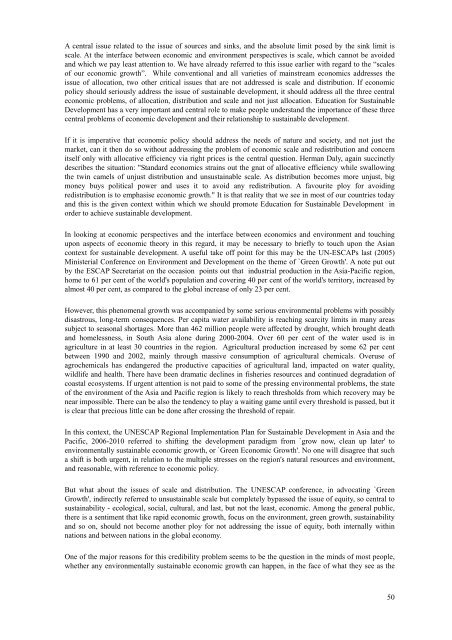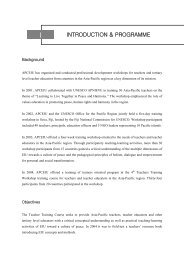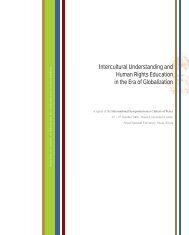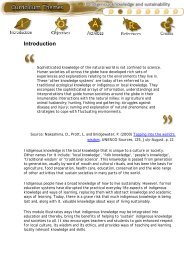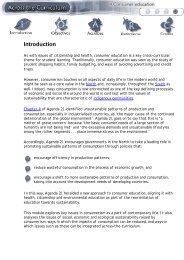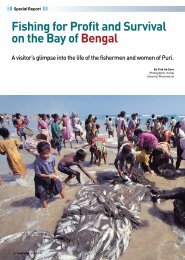REPORT OF UNESCO EXPERT MEETING ON - APCEIU
REPORT OF UNESCO EXPERT MEETING ON - APCEIU
REPORT OF UNESCO EXPERT MEETING ON - APCEIU
Create successful ePaper yourself
Turn your PDF publications into a flip-book with our unique Google optimized e-Paper software.
A central issue related to the issue of sources and sinks, and the absolute limit posed by the sink limit is<br />
scale. At the interface between economic and environment perspectives is scale, which cannot be avoided<br />
and which we pay least attention to. We have already referred to this issue earlier with regard to the “scales<br />
of our economic growth”. While conventional and all varieties of mainstream economics addresses the<br />
issue of allocation, two other critical issues that are not addressed is scale and distribution. If economic<br />
policy should seriously address the issue of sustainable development, it should address all the three central<br />
economic problems, of allocation, distribution and scale and not just allocation. Education for Sustainable<br />
Development has a very important and central role to make people understand the importance of these three<br />
central problems of economic development and their relationship to sustainable development.<br />
If it is imperative that economic policy should address the needs of nature and society, and not just the<br />
market, can it then do so without addressing the problem of economic scale and redistribution and concern<br />
itself only with allocative efficiency via right prices is the central question. Herman Daly, again succinctly<br />
describes the situation: "Standard economics strains out the gnat of allocative efficiency while swallowing<br />
the twin camels of unjust distribution and unsustainable scale. As distribution becomes more unjust, big<br />
money buys political power and uses it to avoid any redistribution. A favourite ploy for avoiding<br />
redistribution is to emphasise economic growth." It is that reality that we see in most of our countries today<br />
and this is the given context within which we should promote Education for Sustainable Development in<br />
order to achieve sustainable development.<br />
In looking at economic perspectives and the interface between economics and environment and touching<br />
upon aspects of economic theory in this regard, it may be necessary to briefly to touch upon the Asian<br />
context for sustainable development. A useful take off point for this may be the UN-ESCAPs last (2005)<br />
Ministerial Conference on Environment and Development on the theme of `Green Growth'. A note put out<br />
by the ESCAP Secretariat on the occasion points out that industrial production in the Asia-Pacific region,<br />
home to 61 per cent of the world's population and covering 40 per cent of the world's territory, increased by<br />
almost 40 per cent, as compared to the global increase of only 23 per cent.<br />
However, this phenomenal growth was accompanied by some serious environmental problems with possibly<br />
disastrous, long-term consequences. Per capita water availability is reaching scarcity limits in many areas<br />
subject to seasonal shortages. More than 462 million people were affected by drought, which brought death<br />
and homelessness, in South Asia alone during 2000-2004. Over 60 per cent of the water used is in<br />
agriculture in at least 30 countries in the region. Agricultural production increased by some 62 per cent<br />
between 1990 and 2002, mainly through massive consumption of agricultural chemicals. Overuse of<br />
agrochemicals has endangered the productive capacities of agricultural land, impacted on water quality,<br />
wildlife and health. There have been dramatic declines in fisheries resources and continued degradation of<br />
coastal ecosystems. If urgent attention is not paid to some of the pressing environmental problems, the state<br />
of the environment of the Asia and Pacific region is likely to reach thresholds from which recovery may be<br />
near impossible. There can be also the tendency to play a waiting game until every threshold is passed, but it<br />
is clear that precious little can be done after crossing the threshold of repair.<br />
In this context, the UNESCAP Regional Implementation Plan for Sustainable Development in Asia and the<br />
Pacific, 2006-2010 referred to shifting the development paradigm from `grow now, clean up later' to<br />
environmentally sustainable economic growth, or `Green Economic Growth'. No one will disagree that such<br />
a shift is both urgent, in relation to the multiple stresses on the region's natural resources and environment,<br />
and reasonable, with reference to economic policy.<br />
But what about the issues of scale and distribution. The UNESCAP conference, in advocating `Green<br />
Growth', indirectly referred to unsustainable scale but completely bypassed the issue of equity, so central to<br />
sustainability - ecological, social, cultural, and last, but not the least, economic. Among the general public,<br />
there is a sentiment that like rapid economic growth, focus on the environment, green growth, sustainability<br />
and so on, should not become another ploy for not addressing the issue of equity, both internally within<br />
nations and between nations in the global economy.<br />
One of the major reasons for this credibility problem seems to be the question in the minds of most people,<br />
whether any environmentally sustainable economic growth can happen, in the face of what they see as the<br />
50


